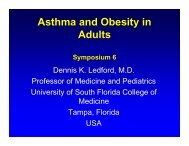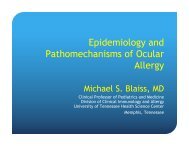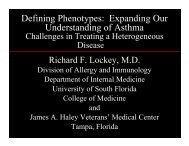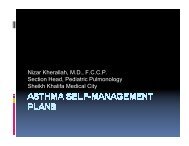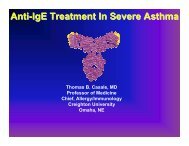Dubai Final-v20.indd - World Allergy Organization
Dubai Final-v20.indd - World Allergy Organization
Dubai Final-v20.indd - World Allergy Organization
Create successful ePaper yourself
Turn your PDF publications into a flip-book with our unique Google optimized e-Paper software.
ABstrACts<br />
2203<br />
FooD allErgY anD aToPiC DErmaTiTiS<br />
Hekmatdoost, Jr., A.<br />
Dep Clinical nutrition and Dietetics, shahid Beheshti University of medical sciences, tehran, iran.<br />
Food allergy is one of the most important factor in children with atopic dermatitis (AD). in this study, we have measured any<br />
association existed between AD severity, quality of life, total igE, eosinophil counts, and the number of food items sensitized.<br />
specific igE of ten common food items was measured for a group of consecutive AD patients (n = 105) enrolled during a<br />
randomized trial and correlated the findings with eczema severity. twenty-nine patients were negative for any of the ten common<br />
food items. the most commonly sensitized foods were caw milk (51%), fish (49%), egg white (41%), and wheat (38%). Atopy to<br />
beef as a protein and orange as a fruit were least common among the food items studied, even among patients positive for 8-9<br />
igE items. Patients with severe AD (objective sCOrAD > 40) were more likely to be positive for at least one of the food items (Yates<br />
corrected p = 0.024 for >/=1 food-specific igE in severe vs. moderate AD, Or 3.42 and 95% Ci 1.15-10.32); and for at least seven<br />
of the food items (p = 0.001 for >/=7 food-specific igE vs. nil with Or 11.67 and 95% Ci 2.29-67.77), respectively. the spearman<br />
coefficients between the number of positive food-specific igE and total sCOrAD, objective sCOrAD, area of AD involvement,<br />
Children’s Dermatology life Quality index (CDlQi), total igE levels, and eosinophil counts were 0.42 (p < 0.001), 0.45 (p < 0.001),<br />
0.50 (p < 0.001), 0.17 (p = 0.116), 0.80 (p < 0.001), and 0.22 (p = 0.043), respectively. specific igE levels for beef correlated with<br />
all the other food-specific igE levels, including cow’s milk (rho = 0.061, p < 0.001) and soy (rho = 0.70, p < 0.001). the number of<br />
common food items sensitized correlated with disease severity, extent, and total igE levels. it seems that many atopic children could<br />
be treated by food limitations.<br />
2204<br />
CliniCal CHaraCTEriSTiCS oF raniTiDinE inDUCED HYPErSEnSiTiViTY<br />
Cho, Y. J.<br />
<strong>Allergy</strong> and Clinical immunology, internal medicine, Ewha Womans University mockdong Hospital, seoul, south Korea.<br />
Purpose: ranitidine is a widely used drug for gastrointestinal problem and is usually associated with a low incidence of adverse<br />
reactions. there have been only a few cases of immediate type hypersensitivity reactions to ranitidine. to see the characteristics of<br />
ranitidine induced hypersensitivity, we analyzed 10 cases of ranitidine induced hypersensitive reaction<br />
methods: Patient who is suspicious of ranitidine induced hypersensitivity was evaluated. skin test and oral provocation were<br />
performed. We also evaluated the cross reactivity of other drugs (cimetidine, famotidine and proton pump inhibitor) used for gastric<br />
protection.<br />
results: Eighty percent of patient was positive in ranitidine skin test and oral provocation test. mean age of these patients was<br />
35 ± 7 years old. male: female ratio was 4:6. two cases illustrates a severe anaphylactic reaction after a single intravenous dose<br />
of 50 mgs of ranitidine and three cases showed anaphylactic reaction after oral intake of dose of 150mg of ranitidine. Five cases<br />
illustrated only skin eruption after oral intake of 150mg of ranitidine. All of five cases who illustrated anaphylactic reaction showed<br />
positive reaction with skin prick test and/or intradermal skin tests. three patients who showed only skin reactions were positive in<br />
intradermal skin test with ranitidine. two of cases were negative for skin test with ranitidine and they showed mild skin eruption<br />
with itching sense in 2 hours and 3 hours each with 75mg of ranitidine of oral provocation test. All of the 10 cases showed<br />
negative reaction in skin test and oral provocation test with cimetidine, famotidine and proton pump inhibitor.<br />
Conclusion: Our case suggests that ranitidine may induce immunoglobulin E-mediated anaphylaxis but also non-immunological<br />
mechanisms may be involved in hypersensitivity reactions.<br />
ranitidine may have very rare cross-reactivity with other gastric protective drugs. Clinicians should therefore be aware of possible<br />
life-threatening adverse reactions to commonly used H2-receptor antagonists such as ranitidine.<br />
2205<br />
PangaSiUS HYPoPHTHalmUS HYPErSEnSiTiViTY<br />
Palomeque, sr., m. t. 1 , torrecillas, m. 1 , Bartolome, B. 2 , martínez Borque, n. 1 , gonzález mendiola, m. r. 1 , martín Casáñez, E. 1 , lara<br />
de la rosa, P. 1 , soto Vargas, g. 1 and martínez Bohigas, D. 1<br />
1 2 Alergología, Complejo Hospitalario Universitario Albacete, Albacete, spain. Departamento i+D, Bial-Arístegui, Bilbao, spain.<br />
introduction: Fish is a relatively common source of food allergens and its ingestion may cause fatal anaphylactic reactions. Fish<br />
allergic subjects usually present igE antibody to several fish species, although clinical cross reactivity may be more limited. We<br />
report a patient allergic to Pangasius hypophthalmus (Panga fish) but no to other fish. this exclusive sensitivity was confirmed by in<br />
www.worldallergy.org 125<br />
FinAl PrOgrAm<br />
ABstrACts





